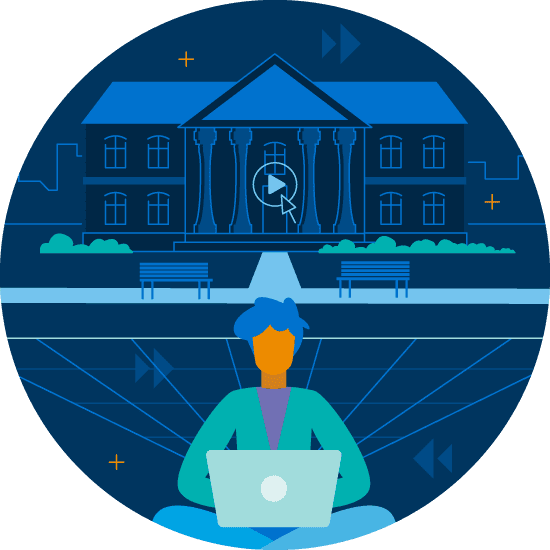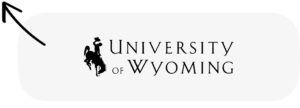Gen Z is the most diverse generation yet. Therefore, they are looking for their school’s campus to be a reflection of this array. That’s where shaping your class comes in. In this three-part eBook, we examine several cohorts of students and how schools are grabbing their attention by showcasing their colleges in virtual campus tours.
Part One: Domestic and International Students

Key Takeaways
1. Show out-of-state students what makes your region unique.
2. How to make your residence life pages standout.
3. How to address international students’ unique worries.
4. See what other schools are doing!
Out-of-State Students
Research by Western Interstate Commission for Higher Education indicates that while the number of high-school graduates is shrinking, some areas are more affected than others. Specifically, the Northeast and Midwest regions suffer more significant declines than elsewhere in the United States. Consequently, the best way to combat these migration patterns is to open up new domestic markets or in other words, focus on out-of-state students.
Geography has value
Hanover College is a midwestern university facing a reduced number of high school graduates in their own state. In their virtual campus tour, you can hear how Hanover uses its unique geographic location to attract potential out of state students.

- Beautiful campus
- 650 wooded acres
- Overlooking Ohio river
- Miles of hiking trails
- Dozens of waterfalls
- Access to one of the nation’s largest rivers
Pro Tip
Although Hanover highlights the nature of their surroundings, there are plenty of other things you can feature that make your location unique.
Examples
– Recreational activities
– Historic spots around town
– Local events and festivals

Another factor that may keep students from outside your immediate region from attending your school is the anxiety of living so far from home. Being away from home for the first time is pressure enough, but being out-of-state can amplify this apprehension.
Flat photos can only do so much to tell the story of dorm life. Our client, Bellarmine, recognized this problem and decided to embed super content (advanced media layering) on their residence life home page.
International Students
In a recent study, admissions officers at six out of ten institutions say international recruiting is as important as domestic recruiting at their institutions. Specifically, this statement is a reflection of efforts to increase diversity and becoming a global campus.
Until recent years, the United States was the top college destination for international students. However, in the last year, data shows the enrollment of international students has seen a decrease of 4%. Although international students share some of the same worries as out-of-state students, they also have some concerns entirely their own.
Start Shaping Your Class
Get more information about creating a virtual tour for your institution.
Request InfoWhile many universities have web pages dedicated to international students housing, tuition, and campus life, they do not highlight these attributes in virtual campus tours. Just like the worries international students have are entirely their own, they need a more relevant virtual tour that speaks to these unique needs.
Inclusivity
One worry international students have is not feeling included on campus. Aware of this fact, many universities have programs in place to promote inclusivity or have hired a Chief Diversity Officer. These are both great things to highlight on an international virtual tour. Similarly, you can also feature bios of current international students on your campus. For instance, one of our clients, Syracuse University, starts their tour by stating, “students from over 130 countries come to Syracuse”. This statement is a great way to promote inclusivity and let other international students know they are not alone.
Post-Graduation
More so than domestic students, international students fear the lack of job security after graduation. The University of Wyoming (tour on the right) does a great job addressing this point (and enrollment complications) by starting and ending their tour in the Marian Rochelle Gateway Center. Notably, it is home to both their office of admissions and career placement services.
Taking a deeper dive with our super content (advanced media layering), you can get a closer look at the location of each office. Thus, again reinforcing the feeling of not being alone throughout college and beyond.
Leverage Immersive Content with Out-of-State and International Students

Both of these groups might wonder what it’s like to live in a different state or country. Therefore, allowing students to immerse themselves in campus lets them take an active role in collecting information.
However, passive gathering leaves interpretation up to the student, but a carefully curated experience, the student has an active role in, can ensure everything was received as intended.
Showing off culture and telling a unique story as we saw in virtual campus tours of Hanover College and The University of Wyoming are great ways to remove anxiety and turn interest into intent.
Part Two: Underserved Communities
Over the past few years, admissions officers have seen a decrease in enrollment numbers. However, there has been an increase in attendance among underserved communities. This type of student includes low-income, first-generation, and underrepresented minorities. These students face significant challenges in their ability to visit campus. On average, 14% fewer of these “high access population” seniors make an official campus visit and those who do, visit fewer schools than their non-access peers.
First Generation College Students
According to the National Center for Education Statistics (NCES), 34% of undergraduates were the first in their families to go to college in the 2011-12 academic year.
Going to college is always a new experience, but for first-generation students, the process is as unfamiliar to them as it is to their parent or guardian. Therefore, it’s important to remember communicating with the parent often is just as vital as communicating with the student. Similarly, it is also important to remember that all the material they receive is probably new to them. Having information is good, but overwhelming them with information isn’t. Presenting specific information suited to their needs is better than giving them everything at once.
For example, send parents text messages with links back to virtual campus tours on your website. Highlight academic programs and buildings that will remind them how proud they are to have their child attend your institution.
With our virtual tour platform, you can embed a 360 video of graduation on a web page. Let them look around and see the proud parents, and imagine their child being the first in their family to receive their diploma.
Low Income Students
Demographers say, what higher education institutions are most unprepared for is the drop in the number of affluent, well-prepared high-school graduates. While this type of students has traditionally been the backbone to admission growth, this is no longer the case. As a result, we need to adjust the information we present for this type of student.
Specifically, financial aid is essential to this type of student. They want to understand things like how much assistance they can hope to receive and when they can expect to receive financial aid. Additionally, covering points like what costs assistance does not include are all critical to highlight.
As an example, Mercy College has a full tour stop dedicated to their mentorship program. This tour stop explains how the college pairs each student with a dedicated mentor who (among other things) will help them understand financial aid. For low or first-generation college students, having this type of reassurance is crucial. By highlighting this type of program at your school, you can take away some of the anxiety college brings.
Underrepresented Minorities
Another shift occurring in universities is the racial and ethnic mix of their student body. According to data from the Western Interstate Commission on Higher Education, 45 percent of the country’s public high school graduates will be non-white by 2020.
Despite the growing ethnicity among their student body, institutions’ staff remains overwhelmingly homogenous. While this may seem unrelated, research shows that increasing diversity of faculty creates a more inclusive campus where discrimination and bias are less prevalent.
| School Year | Hispanic | White | Black | American Indian/ Alaskan Native | Asian/Pacific Islander |
| 2018-19 | 767,254 | 1,754,284 | 461,072 | 28,139 | 196,622 |
| 2019-20 | 777,906 | 1,720,563 | 450,629 | 27,458 | 198,353 |
| 2020-21 | 800,815 | 1,724,512 | 441,955 | 26,662 | 206,196 |
| 2021-22 | 822,484 | 1,719,195 | 438,763 | 26,268 | 209,399 |

Highlighting the diversity of both the student body and the staff helps underrepresented minorities feel more comfortable attending school on your campus. The University of Memphis virtual tour does a great job of doing this. In their intro video, they not only show us minority students but a professor as well. This theme is carried throughout their experience as you see students from an array of different races.
Students from underserved communities may never get a chance to step foot on campus before choosing which college to attend. Therefore, what you feature in your communications to them is more critical than with other cohorts of students. Using immersive content lets these students look around and interact with your school as if they were there. If they can’t come to campus, then bring the campus to them with virtual tours!
Part Three: Inclusivity and Diversity
With enrollment number trending downwards, the focus of recruiting has shifted from making your class to shaping your class. In this section, we will examine how to showcase unique elements of your campus to make students from different backgrounds feel welcome.

Key Takeaways
1. Promoting inclusivity in your messaging
2. Highlight diversity programs on your campus
3. Personalize virtual tours to speak to cohorts needs
Women in STEM
Similarly to other cohorts we examined in part two, it is important to make women in STEM not feel alone on campus. Studies show that even while programs are being run at the national level to promote women in STEM, many still worry about being underrepresented while on campus.
| Rank | Institution | Percent |
| 1 | University of California – San Diego | 32.7% |
| 2 | North Carolina State University – Chapel Hill | 31.5% |
| 3 | University of California – Davis | 23.7% |
| 4 | University of California – Berkeley | 23.5% |
| 5 | Virginia Polytechnic Institute | 22.2% |
| 6 | University of California – Los Angeles | 21.7% |
| 7 | University of Washington – Seattle | 21.6% |
| 8 | University of California – Irvine | 21.5% |
| 9 | University of Michigan – Ann Arbor | 20.9% |
| 10 | University of Wisconsin – Madison | 19.4% |
Schools where women graduate with STEM degrees
Even in the leading schools of women graduating with STEM degrees, these students make up around one-third of the graduates. Although the statistics may not be on your side, there is still a lot you can do to make women in STEM feel welcome. Mills College starts their virtual tour off by calling out their “long-standing commitment to advancing women in the sciences.” Throughout the tour, you can see both women students and teachers within STEM fields. Following this same theme in one of the last tour stops, Mills again states their “commitment to emboldening women and women of color to pursue successful careers in science, technology, engineering, and math.” Lastly, they end their tour by naming the accredited mentors they offer for women in technology. The continual reminder of support is sure to make women feel less isolated in pursuing their dreams in STEM.
In the United States, women make up 35.5% of undergraduate degrees earned in STEM fields.
LGBT
For many students, college offers the prospect of a fresh start, but for others, the memory of a bad high school environment can keep them from enrolling for classes. In a recent poll, 13.4% of frequently harassed LGBTQ high school students said they didn’t plan on attending college. However, in 2016 according to the American College Health Association, LGBT students made up 10% of the incoming class. To win over these students who were treated unkindly during high school, feeling campus is a safe space to express themselves is of utmost importance.
UC San Diego recognized this need and created a tour stop highlighting their LGBT Resource Center. It is not only one of the largest, but most active LGBT communities in the country. They go on to describe the different ways students can get involved on and off-campus.
Veterans
Since the expansion of the GI Bill in 2008 (and again in 2017), the United States covers the full cost of most public or private institutions for veterans. However, the focus on recruiting veterans isn’t what it used to be. Astoundingly, only 10% of G.I Bill beneficiaries enroll in institutions with a six-year graduation rate of above 70%. Additionally, the lack of attendance at top schools is not because veterans can’t succeed, but the lack of attention to this cohort. Recruiting is targeted at traditional students who start college right after high school. However, not targeting veterans, many institutions miss a great opportunity.
Often, veterans feel they don’t fit the mold of the stereotypical freshman student. As such, they don’t feel welcome attending universities. One of our clients, Mercy College Bronx Campus, seeks to remove the stigma that vets aren’t unwanted. As part of their virtual campus tour, they showcase their Veterans Lounge. In this tour stop, you can take a look around and hear from a current student and veteran on his transition to Mercy College.
Athletics
More and more students are looking for colleges that fit their wide range of interests. Traditionally when thinking about recruiting for athletics we think of football or basketball, but The Air Force Academy does things a little differently in their virtual tour. They have a separate tour dedicate to their numerous athletic programs. Whether a student is interested in football, hockey, or even archery their athletics program has something unique to offer. It’s important to let students know they don’t have to leave their hobbies at home when attending campus.
Recruiting for the masses makes many cohorts for students feel left out. Institutions can take a more personalized approach that speaks to specific needs and concerns different groups of students have. There are significant initiatives on campus already running. Learning how to highlight them in your messaging in an authentic way can make these minorities feel included.
This resource requires EAB partnership access to view.
Access the tool
Learn how you can get access to this resource as well as hands-on support from our experts through Strategic Advisory Services.
Learn More
